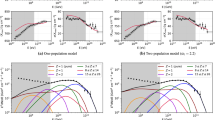Abstract.
Simple arguments concerning power and acceleration effciency show that ultra-high energy cosmic rays (UHECRS) with energies \(\gtrsim 10^{19}\) eV could originate from GRBs. Neutrons formed through photo-pion production processes in GRB blast waves leave the acceleration site and travel through intergalactic space, where they decay and inject a very energetic proton and electron component into intergalactic space. The neutron-decay protons form a component of the UHECRs, whereas the neutron-decay electrons produce optical/X-ray synchrotron and gamma radiation from Compton-scattered background radiation. A significant fraction of galaxies with GRB activity should be surrounded by neutron-decay halos of characteristic size \(\sim 100\) kpc.
Similar content being viewed by others
Author information
Authors and Affiliations
Editor information
Rights and permissions
About this paper
Cite this paper
Dermer, C.D. Ultra-high Energy Cosmic Rays and Neutron-Decay Halos from Gamma Ray Bursts. In: Costa, E., Frontera, F., Hjorth, J. (eds) Gamma-Ray Bursts in the Afterglow Era. ESO ASTROPHYSICS SYMPOSIA. Springer, Berlin, Heidelberg. https://doi.org/10.1007/10853853_71
Download citation
DOI: https://doi.org/10.1007/10853853_71
Published:
Publisher Name: Springer, Berlin, Heidelberg
Print ISBN: 978-3-540-42771-1
Online ISBN: 978-3-540-45505-9
eBook Packages: Springer Book Archive




